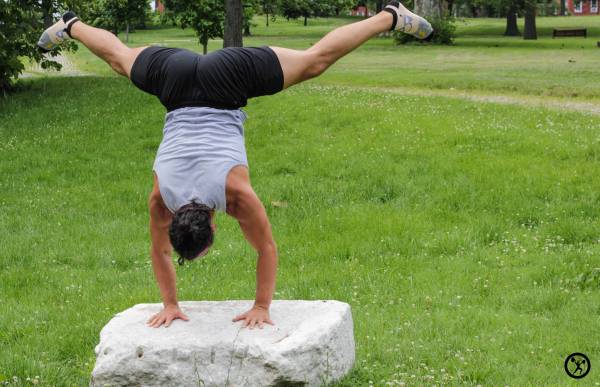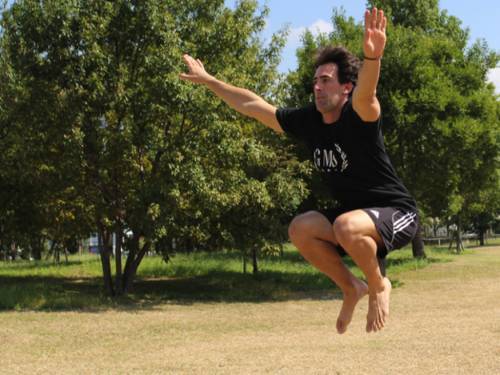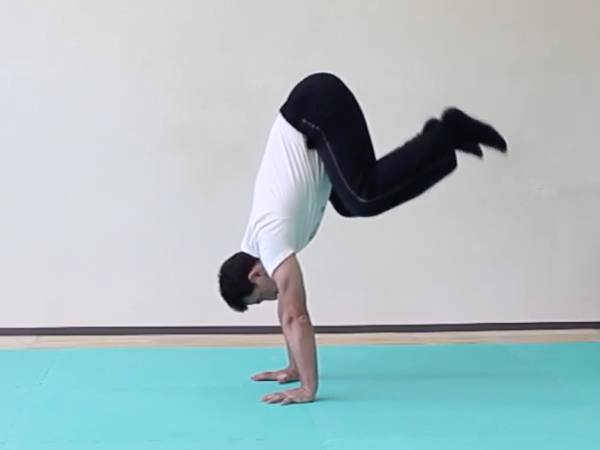As a mom who works at home with three kids, bodyweight training has been a lifesaver. A workout you can take to the playground is bound to be a keeper. And I’m not the only one who feels that way. Bodyweight exercise has been trending in the fitness world for some time, and with its effectiveness and versatility, there’s no wonder.
Proficiency in more advanced bodyweight movements comes from one thing: practice. But we all know there’s practice, and then there’s good practice. These four tips from our coaches will help you design effective bodyweight training programs you can do on your own time with minimal equipment.
Time at the playground can be time to train.
1. Add in Isometrics
One of the easiest ways to ramp up your bodyweight training is by adding isometrics. Coach Jeremy DuVall explained how to use them correctly in his article, How to Use Bodyweight Training to Build Bigger Muscles.
Isometrics are often neglected in fitness routines for one reason or another. When applied correctly, they can be a valuable addition to any strength or hypertrophy routine. Alongside growth, they also increase joint stability and strength.
To make the most of isometrics, focus on building tension across the entire muscle. Certain joint positions place more emphasis on the bony structures rather than the contracting muscle. In a push-up for instance, hanging out at the top (with arms fully locked out) puts the majority of the stress on the shoulder joint and takes strain off the chest – not the desired outcome. Instead, gradually move into the position of most muscle tension and hang out. For the majority of exercises, this is going to be when the joint in question is around 90 degrees or slightly greater. For push-ups, this means the elbow joint is close to a right angle.
2. Move Beyond Push Ups
In an excerpt from his book Convict Conditioning, Paul Wade described the type of strength you can achieve with a progressive calisthenics program. He also explained why you need to move beyond the typical mix of push ups, pull ups, and squats.
“Calisthenics” currently involves push ups, pull ups and squats; all fine exercises, but done for high repetitions which will build stamina though develop little in the way of strength. A real master of progressive calisthenics – “old school” calisthenics – also knows how to build maximum raw strength.
Much more than the average trainee could possibly hope to develop with a barbell or a resistance machine. I’ve seen men trained in old school calisthenics who were powerful enough to break steel handcuffs, tear apart a chain-link fence, and punch a wall hard enough to take big chunks out of it, splitting the bricks in the process. How would you like that kind of awesome bodily strength?”
If you want to know what that looks like, click here to access the first day of training from Wade’s three-week training program.

Use a variety of exercises to challenge your entire body.
3. Integrate Strength Training
Just because you do bodyweight training doesn’t mean you can’t move weight other than your own. In fact, depending on your goals, it might make more sense to combine bodyweight and weight training.
In his article Combining Bodyweight Exercise and Weight Training for Maximum Benefit, Coach Ryan Hurst explained why setting goals is the most important step in determining whether or not to combine the two modalities:
The decision to train with a particular method should be based solely on your own goals and, therefore, your own needs. I started incorporating more weight training into my fitness regimen earlier this year, when I decided I needed to fill in some gaps in my development.
Here’s an example of a workout plan from Ryan, designed to work you up to a front flip:
Day 1:
- Front flip practice (as determined by qualified coach)
- Jumps from full bottom squat position to full jump with knees brought high to chest: 10 sets of 3. Rest 2-3 minutes between sets (pictured below)
- Front squats: 8 sets of 3. Increase weight to your heaviest weight on the last set. Rest 2-3 minutes between sets.
- Straight-arm pulldown: 5 sets of 5. Rest 1-2 minutes between sets.
- Frogger jumps: 3 sets of 12. Rest 1 minute between sets (pictured below)
- V-ups: 3 sets of max reps. Rest 1 minute between sets.
Day 2
- Front flip practice Pull ups: 3 sets of 5 weighted pull-ups, then 2 sets of bodyweight pull-ups for max reps. Rest 2 minute between sets.
- Jumps from half squat position for maximum height: 10 sets of 3. Rest 2 minutes between sets.
- Machine calf raises: 5 sets of 12-15 reps. Rest 1 minute between sets
- Hanging leg raises: 3 sets of max reps. Rest 1 minute between sets.

Jumps from bottom squat position to full jump with knees brought to chest

Frogger jumps
4. Time Is On Your Side
Time under tension (TUT) is a common practice in strength training, and it’s no less useful for bodyweight exercise. In the article, How to Maximize Size and Strength With Bodyweight Exercise, Andrew Read explained how to use TUT:
Once a muscle contracts beyond 50%, blood flow is occluded, meaning that waste products build up within the muscle. Higher levels of lactate form, which in turn pushes growth hormone production up.
To take advantage of this method Convict Conditioning author Paul Wade suggests taking a full five seconds to perform every rep of an exercise. Do this by lowering to a two count, pausing at the bottom position for a full second, and then slowly raising yourself back to the start for another two count. Taking out the momentum and bouncing from the movement is a great way to develop control and end range strength too.
4 Sample Programs
If you feel ready to get started with a bodyweight program but aren’t quite ready to create your own, you’ve come to the right place. Here are four bodyweight programs from our coaches to help you reach a variety of goals:
A 12-week cycle by coach Mindith Rahmat that focuses on on holds, strength, and flexibility using arm balances, inversions, and deep flexibility work. You will be able to measure your progress with three attempts at a baseline test in weeks 1, 6, and 12.
This 12-week cycle of bodyweight workouts by coach Mindith Rahmat will focus on flexibility, agility, and recovery. All workouts in this cycle are twenty minutes or less, allowing extra time for the pre- and post-workout mobility, flexibility, and recovery work.
This karate-based conditioning program by Todd Kuslikis is comprised of upper-body, lower-body, core, and whole-body exercises to help you build muscle and achieve a lean physique.
This 12-week cycle of the bodyweight workout series by coach Mindith Rahmat focuses on developing balance and strength with the use of one-limbed movements. This combination of bodyweight exercises will challenge your strength, balance, and flexibility.
How has bodyweight training helped you? Share your experiences and questions in the comments section below!
More Like This:
- The 16 Weeks Ultimate Bodyweight Challenge
- 36 Weeks of Bodyweight Workouts (108 Workouts!)
- The 8-Minute Bodyweight Circuit: Does It Really Work?
- New on Pulse Beat Fit Today
Photos 1 and 2 courtesy of Pulse Beat Fit.






